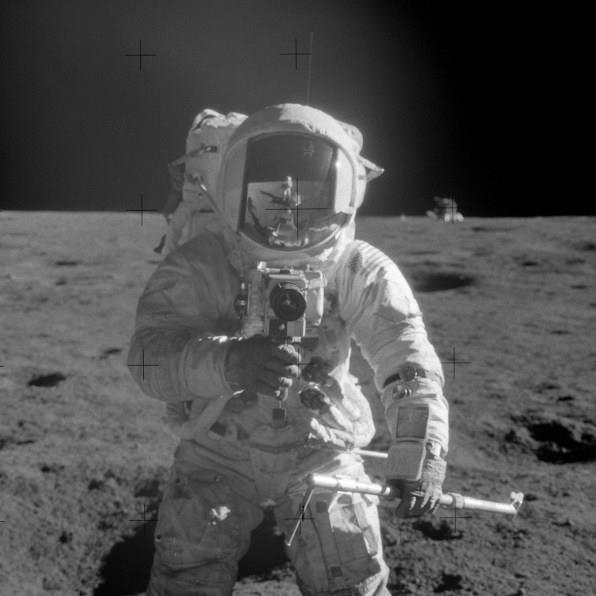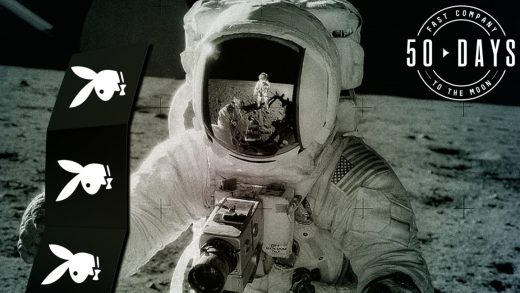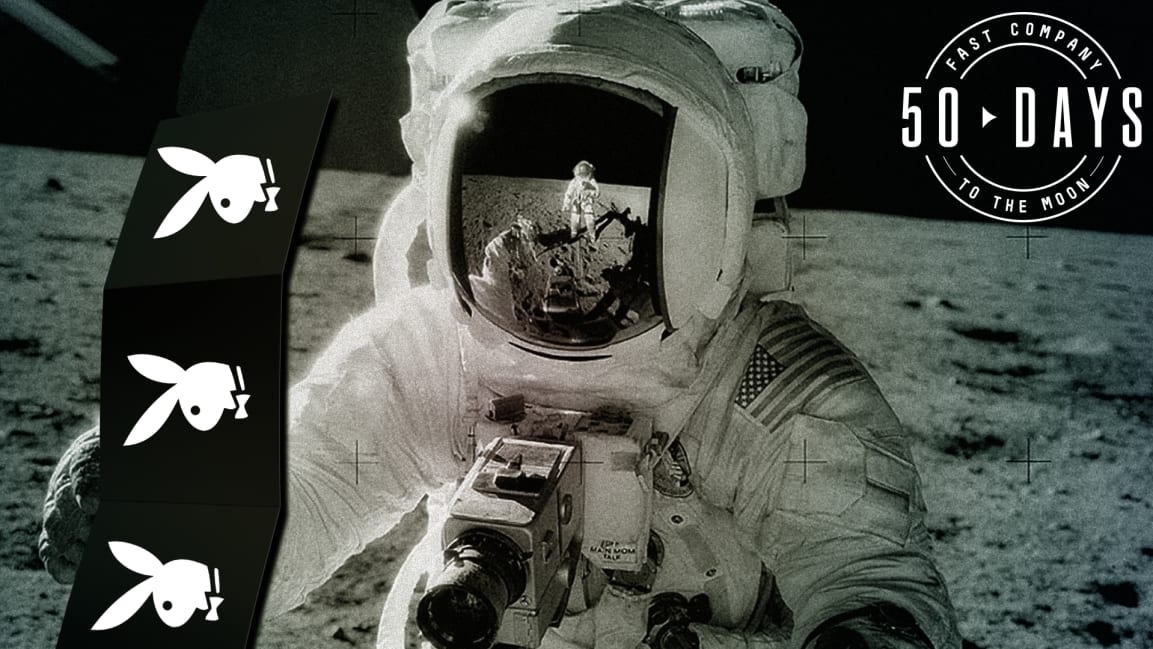Playboy Playmates went to the Moon—but almost no one knew it for 25 years
This is the 36th in an exclusive series of 50 articles, one published each day until July 20, exploring the 50th anniversary of the first-ever Moon landing. You can check out 50 Days to the Moon here every day.
There aren’t many chapters of Moon landing history that have remained hidden 50 years on, especially involving actual equipment that went out onto the surface of the Moon. But the story of the four Playboy Playmates who made it to the Moon is one of those. The Playmates were, in fact, part of the official equipment that NASA sent to the Moon (although not on the authorized equipment list, to be sure), and one of the Playmates even appears in one of the most famous and reproduced photos from the Apollo 12 landing.
The Playmate incident was a playful prank played by one set of astronauts on another; the prankishness of it hasn’t aged well since 1969, but it was certainly an indication of the larger cultural moment in which the Moon missions took place—and also how that moment was shifting.
The story hinges on an essential but little-noticed piece of Moon-walk equipment: the checklist on the wrists of the astronauts.
Apollo 12 was the second Moon landing mission—with commander Pete Conrad and lunar module pilot Alan Bean riding lunar module Intrepid to the surface, and Dick Gordon remaining in Moon orbit in the command module.
Conrad and Bean had two Moon walks—Apollo 11 had only had one—and each of those was about four hours.
NASA scripted all kinds of tasks for the Moon walks: equipment deployment, exploration, sample-taking, core-drilling, flag-raising. To keep the tasks straight, the astronauts were given checklists of what to do and in what order.
For that first Moon walk, with Neil Armstrong and Buzz Aldrin, the list of tasks for their two-hour excursion fit on a single panel, which was sewed onto the flaring cuff of each astronaut’s spacesuit glove.
For Apollo 12’s Conrad and Bean, though, with eight hours of Moon walking, their to-do list was much longer: Conrad’s checklist was 34 pages long, Bean’s was 30 pages, each page a 3.5-inch square. The pages—printed on laminated fireproof paper—were assembled into a small spiral-bound book, the little flip-book itself secured around the cuff of the spacesuit glove with a strap. The astronauts did different jobs on the Moon, to maximize the work that could be done, but sometimes they worked together. At the one-hour mark in each checklist is the instruction “deploy flag.”
The checklists were technical documents filled with cryptic acronyms, brief instructions, and the occasional diagram, but on about half the pages, someone had sketched lighthearted cartoons of astronauts going about their jobs on the Moon—setting up a radio antenna, using a hammer to pound the flagpole into the lunar surface, photographing each other.
For Conrad and Bean, the cuff checklists contained a cheekier surprise. Each one had pictures of two Playboy Playmates, the photos taken directly from the magazine, photocopied down to size, put on the special paper, laminated, and secretly bound into the checklists after they had been reviewed by the astronauts. It was orchestrated by Dave Scott, who would go on to command Apollo 15.
Bean was apparently the first to find one of the Playmates in his checklist. Cynthia Myers (Miss December 1969) is about nine pages in, smiling and wearing a Santa hat and nothing else. Beneath her picture is a double entendre for a caption, satirizing one of the Moon chores.
“It was about two and a half hours into the extravehicular activity,” said Bean. “I flipped the page over and there she was. I hopped over to where Pete was and showed him mine, and he showed me his.”
There’s not a whisper of the discovery on the radio exchanges between Apollo 12 and Mission Control. “We didn’t say anything on the air,” Bean said. “We thought some people back on Earth might become upset if they found out we had Playboy Playmates in our checklists. They would have said, ‘This is where our tax money is going?’ ”
But the astronauts appreciated the gag. “We giggled and laughed so much,” said Conrad, “that people accused us of being drunk or having ‘space rapture.’ ”
One unusual element of the Apollo 12 mission made the Playmates easier to keep hidden. There was no TV coverage of the Moon walks. Apollo 12 had carried the first color TV camera to the surface of the Moon, and it recorded Conrad and Bean coming down the ladder to the surface. But as Bean was getting it set up to survey their activities at the landing site, he accidentally pointed the lens at the Sun for a few seconds too long, and the camera’s electronic sensor burned out.
Word about the Playboy Playmates reaching the Moon apparently never reached reporters, during Apollo 12’s flight or after.
The first story published about it appeared in Playboy itself, in December 1994, on the 25th anniversary of the flight, and it’s not clear the women themselves knew before then that their pictures had gone to the Moon. The women in Conrad’s checklist were Angela Dorian (Miss September 1967) and Reagan Wilson (Miss October 1967). In Bean’s checklist, Myers, wearing her Santa hat, and Leslie Bianchini (Miss January 1969).
The women themselves—three of whom appear to be alive—have never spoken publicly about their likenesses traveling to the Moon.
The Playboy prank is an indication of just how male the space-flight system was in those days—not just the astronauts (there wouldn’t be a group of U.S. astronauts chosen for training that included women until 1978, and the first U.S. woman in space was Sally Ride, who flew in 1983), but also the ranks of crew preparation as well. At the same time, the world in the late 1960s was already changing fast enough that the astronauts, and NASA itself, was self-conscious enough not to let anyone know about this particular practical joke.
But as part of the meticulous record keeping of the Apollo missions, images of every page of most of the Apollo Moon walk checklist are available online, all part of a remarkable library of documents, transcripts, and images called the Apollo Lunar Surface Journal. If you scroll through the pages of the Apollo 12 checklists, there are Dorian and Wilson, Myers and Bianchini. On each web page index, the photos are noted as Playmate No. 1 and Playmate No. 2.
More significantly, there is inadvertent photographic evidence of the prank right from the surface of the Moon. One of the iconic photos from Apollo 12 is a close-up portrait of Pete Conrad, in his spacesuit, facing the camera and holding another camera. The lunar module Intrepid is visible in the distance over his left shoulder. Alan Bean, taking the picture, is reflected in the visor of Conrad’s helmet.

On Conrad’s left arm, his cuff checklist is open, and it just happens to be open to the page where Reagan Wilson is reclining on a hay bale. In the photo, the image is too grainy to spot at a glance, but if you know it’s there, you can see it’s not a routine checklist page. Conrad himself, in fact, had that photo framed in his home but didn’t notice for years that Wilson was on his wrist.
A Playboy Playmate not only flew to the Moon, it turns out—she was also photographed there.
Charles Fishman, who has written for Fast Company since its inception, has spent the past four years researching and writing One Giant Leap, his New York Times best-selling book about how it took 400,000 people, 20,000 companies, and one federal government to get 27 people to the Moon. (You can order it here.)
For each of the next 50 days, we’ll be posting a new story from Fishman—one you’ve likely never heard before—about the first effort to get to the Moon that illuminates both the historical effort and the current ones. New posts will appear here daily as well as be distributed via Fast Company’s social media. (Follow along at #50DaysToTheMoon).
(57)



